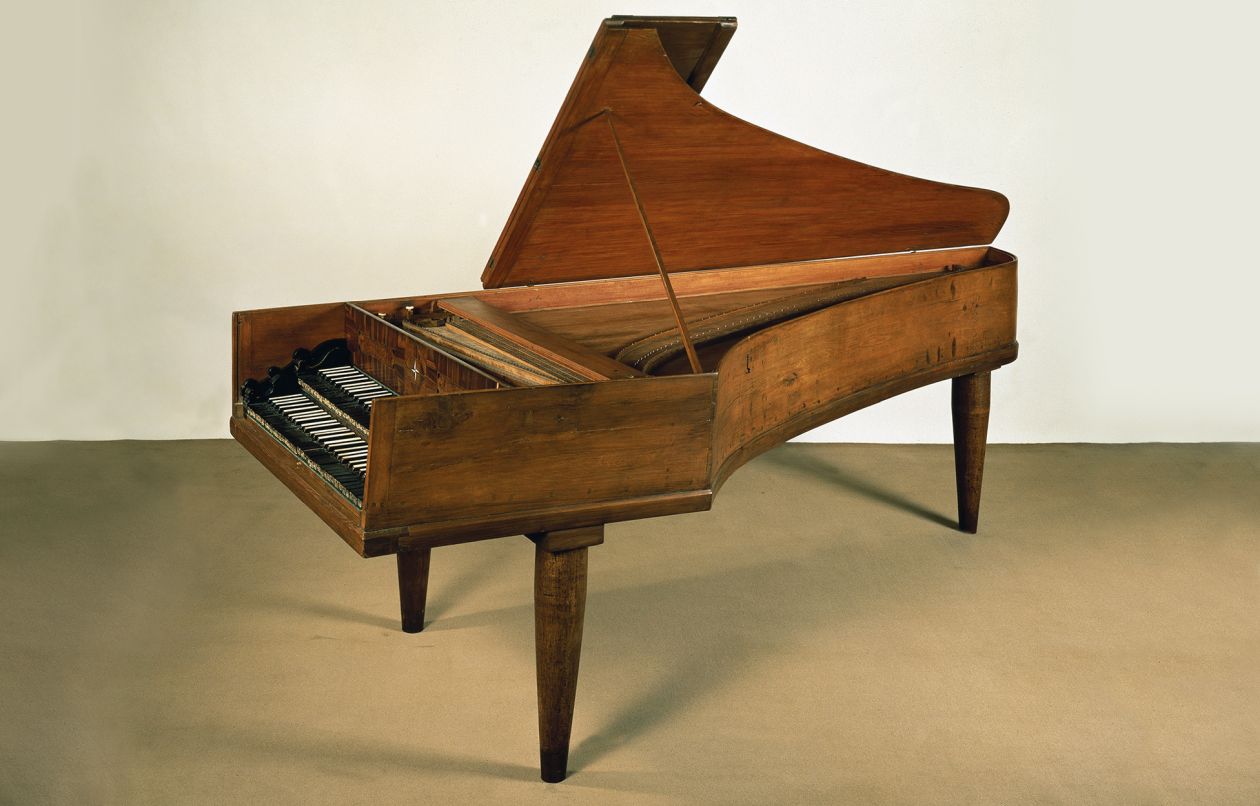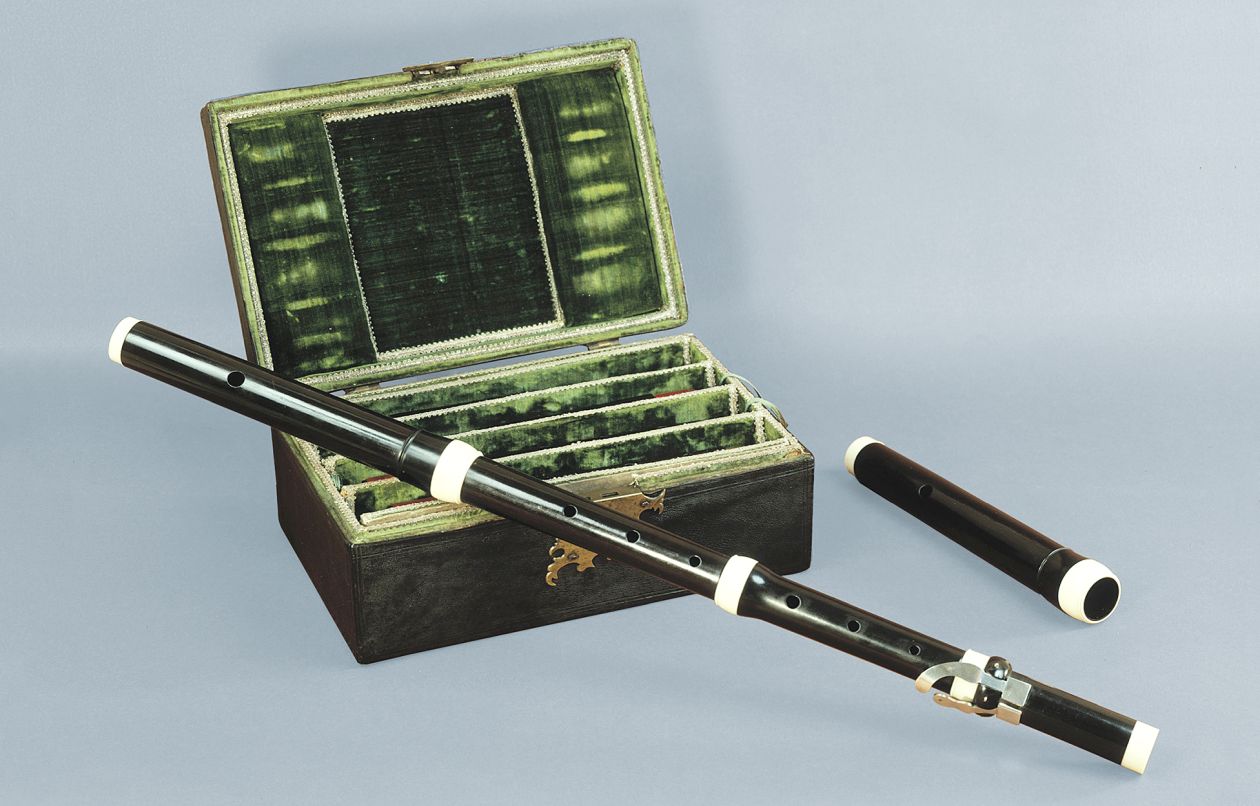Bereichsnavigation
Highlights of the Exhibition
One of the highlights of the display collection is a nearly complete set of wind instruments used by the town pipers of Naumburg, Germany, in around 1600. Other gems of the collection include the famous Bach harpsichord (the original as well as later replicas), transverse flutes that belonged to Frederick the Great, a folding harpsichord owned by Sophie Charlotte of Prussia, Carl Maria von Weber’s fortepiano, an English church organ from the workshop of John Gray, and the largest theater organ in continental Europe, the four-manual Mighty Wurlitzer, which is still regularly used in concerts.
The Naumburg wind instruments

A unique collection of early Baroque wind instruments from the Church of St. Wenceslaus in Naumburg.
It was through a remarkable stroke of good fortune that the Musikinstrumenten-Museum (Museum of Musical Instruments) came into possession of an extensive collection of rare early Baroque wind instruments from the first half of the seventeenth century. In 1657, Andreas Unger, a cantor in the town of Naumburg, died and bequeathed his collection of musical instruments to the local Church of St. Wenceslaus. These instruments were preserved for centuries out of respect for the donor – even though they quickly fell out of fashion and no longer had any practical value.
The instruments are the kind that were typically used by town pipers: rauschpfeifen, bombards, dulcians, crumhorns, recorders, transverse flutes, cornetts, sackbuts and trumpets. They were played at church services and on special occasions such as weddings or house concerts. One unusual feature of the Naumburg Collection is that the instruments come in families or “consorts”: there are discant, alto, tenor and bass versions of a particular instrument type.
Audio sample
The “Bach Harpsichord”

A model instrument: was this harpsichord played by Johann Sebastian Bach himself?
Among the instruments at the Musikinstrumenten-Museum, the "Bach harpsichord" is held in special veneration. According to tradition, it was owned by Wilhelm Friedemann Bach, who is said to have inherited it from his father, Johann Sebastian. There is no actual proof of this, however. The instrument was very likely built by a member of the Harrass family from the town of Grossbreitenbach in Thuringia.
The aura surrounding the Bach name and the special disposition of the instrument (16', 8' and 4’) made the Bach harpsichord something of an archetype, and numerous replicas were made beginning in the first half of the twentieth century. In recent times, two replicas were built in the Musikinstrumenten-Museum itself by instrument makers Horst Rase and Thomas Lerch. To the greatest extent possible, these reproductions sought to match the materials, mechanical design and sound of the original instrument, which is no longer playable. Over the years, the original instrument was substantially modified a number of times in the course of repairs and extensions. The two reproductions represent distinct historical states of the Bach harpsichord.
Audio sample
Flutes owned by Frederick II

Truly royal instruments: the music enthusiast Frederick II of Prussia treasured his transverse flutes.
Frederick II, King of Prussia, was an enthusiastic music lover and accomplished flute player. Long before his accession to the throne, Frederick surrounded himself with musicians in Ruppin and Rheinsberg. These men, who tutored the crown prince and played music with him, included Carl Heinrich Graun, who would later be Frederick's director of music at the royal court, Franz Benda, Carl Philipp Emanuel Bach, and Johann Joachim Quantz. Quantz was a particularly important figure who was responsible for teaching Frederick the flute and participating in the evening chamber music.
The museum has a number of transverse flutes that were owned by Frederick II, including one of ebony and one of ivory. The attribution is supported by a handwritten monogram ("FR", which stands for Fredericus Rex) and written records from around 1800. Two of these instruments were likely created according to Quantz’s specifications. There are two more flutes, with cases, made by I. Scherer from Butzbach (Hessen) in the second half of the eighteenth century.
Frederick II also had a fingering chart, as evidenced by a notation at the bottom left of the page: “Frederici a Berlin ce Janivier 1753”. This was presumably created by Quantz.
Audio sample
The Mighty Wurlitzer theater organ

It is one of the most imposing theater organs in Europe and produces an impressive range of sounds – rolling thunder or chirping birdsong, wailing sirens or pealing bells.
In 1929, Werner Ferdinand von Siemens, grandson of the man who founded the Siemens company, purchased this four-manual instrument from the Rudolph Wurlitzer Company in North Tonawanda, New York. It is the largest of its kind on the European continent and has fifteen ranks (rows of pipes). All of the pipework is located in three glass-covered compartments in the gallery of the museum, along with the instruments for special effects and percussion. The horseshoe-shaped, white-lacquered console of the organ is equipped with its own lights and occupies a position in the middle of the museum, while its relay station and wind-generation system are located in separate rooms in the basement. The Mighty Wurlitzer has a total of 1228 pipes and over 200 stops. It incorporates a large number of percussion instruments as well. All of the sounds are generated purely acoustically. The organ keys are connected to the pipes via electrical relays.
Theater organs were originally used in the 1920s to provide musical accompaniment to silent films. Later, virtuoso organists gave performances on them. Today, the Mighty Wurlitzer in Berlin is regularly played during guided tours, silent film screenings and special concerts. A number of CD recordings are available in the museum shop.
Video
Tip
Demonstration of the Mighty Wurlitzer every Saturday at 12 noon in the museum
The folding harpsichord (clavecin brisé)

This collapsible and portable harpsichord was a rare and precious instrument at the Prussian court.
A true rarity in the collection of the Musikinstrumenten-Museum is the portable harpsichord from the court of Frederick II. Constructed between 1700 and 1704 in Paris, it was based on the clavecin brisé (“broken harpsichord”) invented by the Frenchman Jean Marius. The clavecin brisé in our museum was a gift from the Duchess of Orléans to Queen Sophie Charlotte of Prussia. It is branded with the wording "EXCLUSIF PRIVILEGE DU ROY" and "MARIUS."
The instrument consists of three sections that can be folded up after the keyboards are pushed in, resulting in a long, closed box that could be easily stored and transported. The left flank of the bass section has a special mechanism that can be used to apply a well-tempered tuning.
The folding harpsichord is the only preserved keyboard instrument to have passed from the Preussische Kunstkammer to the Musikinstrumenten-Museum.
Video
The glass harmonica

Benjamin Franklin, the great physicist and politician, invented not just the lightning conductor but also the glass harmonica.
Benjamin Franklin, the great physicist and politician, invented not just the lightning conductor but also the glass harmonica. In 1761, Franklin was inspired by the performance of a man who skillfully created music on wine glasses. He subsequently built an instrument in which semi-spherical glass bowls of various sizes were arranged on a spindle that could be set in motion through a foot pedal. The music created by touching the rotating bowls with wet fingers had a distinctive, ethereal quality. A number of composers have created works for this rare instrument, including Mozart and Beethoven. Richard Strauss wrote a part for the glass harmonica in the third act of his opera The Woman without a Shadow.
The museum's glass harmonica is unsigned. However, certain structural features indicate that it was produced around 1810 in southern Germany or Austria. The forty-four bowls of the harmonica range in tone from d to a'''. Gold paint was applied to the inner rims of the semitone bowls to make them more easily identifiable to the player.
Audio sample
The "Weber Fortepiano"

It was on this fortepiano from the Viennese workshop of Joseph Brodmann that Carl Maria von Weber composed his opera Freischütz.
Carl Maria von Weber bought this fortepiano from Joseph Brodmann while on a concert tour in 1813. In a letter to his brother, Weber related how happy he was with the purchase: “I have bought two marvelous instruments, one from Streicher and one from Brodmann. Over the course of a day, I must have seen fifty different instruments from Schanz, Walter, Wachtl, etc., none of which were worth a charge of powder compared to these.” In 1881, Weber’s son bequeathed the Brodmann fortepiano to Kaiser Wilhelm I, King of Prussia. In 1889, Kaiser Wilhelm II then gave it to the Collection of Early Musical Instruments at the Royal Academy for Music in Berlin.
Joseph Brodmann (1771–1848) was one of the best-known piano makers in early nineteenth-century Vienna. His instruments were highly esteemed by numerous composers, including Beethoven. When Brodmann died, his workshop was taken over by his former apprentice Ignaz Bösendorfer.
With its light touch and shallow key dip, the instrument perfectly suited the brilliant playing style of the era, in which rapid passages were used display virtuosity.
Audio sample
The Gray organ

A masterfully crafted instrument from the early nineteenth century.
For aficionados of historic organs, the Musikinstrumenten-Museum offers a special attraction: a three-manual slider chest organ with chair organ (rückpositiv) made by Gray, the famous organ manufacturer in London. It was built between 1815 and 1820, presumably by John Gray, for a church in Bathampton, near Bath, England. The organ has twenty-four stops. Its disposition consists of the great organ, choir organ and swell organ, each with a range of C–f'''. It also has a pedal that was added after the organ was built (C–f’), as well as couplers and other accessories. The organ has been professionally restored by the E. F. Walcker company, including the neo-Gothic case, a task for which the well-preserved chair organ served as a model. The instrument's original, historical tuning was likewise recreated.
With the soft sound of its generously proportioned pipes, the Gray organ stands squarely in the baroque tradition of organ building that prevailed in the conservative England of the early nineteenth century.

